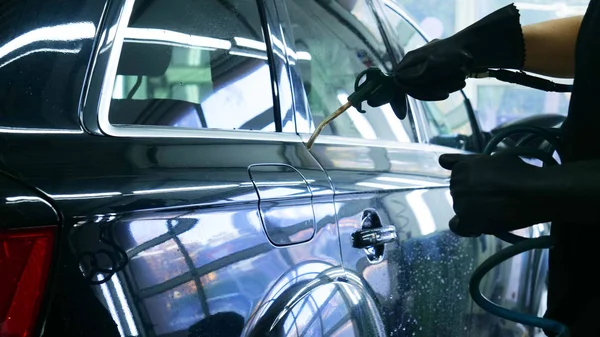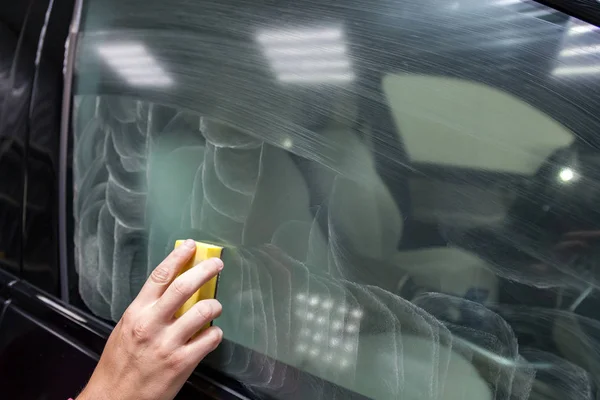In recent years, waterless car wash products have gained popularity, especially among eco-conscious consumers and urban dwellers.
Marketed as a convenient and environmentally friendly alternative to traditional car washes, these products promise to clean your car without the need for a single drop of water. But are they really as beneficial as they seem?
This blog post aims to uncover the truth about waterless car washes, highlighting the potential downsides and what they might mean for your vehicle’s longevity and appearance.

What Exactly is a Waterless Car Wash?
A waterless car wash is exactly what it sounds like—a car wash that requires no water. These products usually come in the form of a spray, which you apply to the car’s surface.
After spraying, you use a clean microfiber towel to wipe the dirt away, leaving a clean and shiny finish. The idea is to reduce water consumption and offer a quick cleaning solution for busy individuals.
Though this concept sounds appealing, it’s essential to understand how these products work.
Typically, the spray contains a mix of lubricants and cleaning agents designed to encapsulate dirt particles, allowing them to be wiped off without scratching the painted surfaces.
However, the effectiveness of this method can vary significantly based on the quality of the product and how it’s used.
Why Waterless Car Washes Are Popular
The popularity of waterless car washes is growing for several reasons.
First, they offer convenience. You can wash your car easily anywhere, whether it’s parked on the street or in your driveway.
There’s no need for hoses, buckets, or large amounts of car soap, making the process quicker and easier. This appeals to urban dwellers who may lack access to traditional car washing facilities.
Secondly, waterless washes are often marketed as environmentally friendly. Given the increasing focus on sustainability, many consumers see these products as a way to save water and reduce the environmental impact of car cleaning.
Waterless wash products are also easy to store and transport, making them a convenient option for road trips.
Lastly, they can be cost-effective. While a single bottle of waterless car wash spray might seem expensive upfront, it can often clean your car multiple times, offering great value compared to traditional car washes that charge per wash.

The Hidden Dangers of Using a Waterless Wash
Despite their apparent advantages, waterless car washes come with some significant risks. One of the primary concerns is the potential for scratches and damage to your car’s finish.
When you wipe clean a dirty car with a cloth, there’s always a risk of dragging dirt particles across the paint, which can cause scratches and swirl marks.
Another issue is the limitation of waterless wash products in thoroughly cleaning the car.
While they can be effective for light dust and fingerprints, they struggle with more stubborn grime like bird droppings, road grime, or mud.
For these tougher contaminants, a traditional car wash with water and car soap is typically more effective.
Additionally, waterless car washes don’t remove contaminants like water spots and certain types of stains that can affect your car’s paint over time.
This means that while your car might look clean initially, it could suffer from long-term damage that diminishes its appearance and value.
How to Use Waterless Car Wash Products Safely
If you decide to use a waterless car wash, there are ways to minimize the risks.
First, ensure you’re using a high-quality waterless car wash product that’s specially formulated for your car’s finish.
Cheap brands may not provide the lubrication needed to prevent scratches.
Use four microfiber towels to avoid re-depositing dirt onto the car’s surface. Start with one section at a time and change to a fresh towel when one becomes dirty.
This minimizes the risk of scratching your vehicle.
Pay attention to the amount of dirt on your car.
If it’s too dirty, consider a traditional wash first. Waterless products are best used for quick touch-ups rather than full deep cleans.
Alternatives to Waterless Car Washes
For those concerned about water consumption but wary of waterless products, consider other eco-friendly car washing methods.
Low-pressure hoses and water-saving nozzles can significantly decrease the quantity of water used during a traditional wash.
Another option is a rinse-less car wash. These products require some water but far less than a standard wash.
You simply mix the solution in a bucket, use it to clean the car with a sponge or cloth, and then dry the surfaces with a towel.

Love My Car Car Wash
Professional car wash services at Love My Car Car Wash is another option.
They use clean water and high-quality cleaning products, offering an environmentally responsible alternative without compromising the quality of the wash.
The trained professionals know how to clean every inch of your car without leaving a scratch.
Good Alternatives to Waterless Car Washes
If you’re looking for effective ways to clean your vehicle without using waterless car washes, here are six alternative products that can help maintain your car’s appearance while addressing some of the concerns associated with even the best waterless car wash options:
- Traditional Car Wash Shampoo: A high-quality car wash shampoo is essential for providing a thorough clean without risking damage to the paint. Buy Car Wash Shampoo
- Foaming Car Wash Gun: This tool uses foam to gently lift dirt and grime from the surface, providing a more effective wash without excessive scrubbing. Buy Foaming Car Wash Gun
- Two-Bucket Wash System: Utilizing a two-bucket method (one for soapy water and one for rinsing) helps prevent dirt from scratching your vehicle while cleaning. Buy Two-Bucket Wash System
- Microfiber Wash Mitt: A microfiber wash mitt is gentle on paint and effective at capturing dirt, making it an ideal companion for traditional washing methods. Buy Microfiber Wash Mitt
- Clay Bar Kit: Clay bars are excellent for removing embedded contaminants from the surface of your vehicle, helping to restore shine and smoothness. Buy Clay Bar Kit
- Protective Wax or Sealant: Applying a good quality wax or sealant can offer long-lasting protection and enhance the paint’s depth, giving your car a glossy finish. Buy Car Wax
These products provide effective alternatives and complement traditional cleaning methods while ensuring your vehicle remains in excellent condition.

Long-term Effects of Waterless Car Washes on Vehicle Surfaces
Over time, the repeated use of waterless wash products can lead to diminished paint quality.
While these products might provide a temporary shine, they don’t offer the same level of protection as traditional waxing or a ceramic coating.
Painted and exterior surfaces can become dull if not properly maintained.
Traditional car washes often include protective treatments like wax, which help maintain the car’s shine and protect against environmental factors.
Without these, waterless car washes leave your vehicle vulnerable to UV rays and pollutants
Additionally, inconsistency in cleaning ability can mean that some areas of the car become more worn than others. This uneven treatment can affect both the car’s aesthetic appeal and resale value.

Environmental Impact of Waterless Car Washes
While waterless car washes save water, the environmental benefits aren’t entirely clear-cut.
The production and disposal of plastic bottles for sprays and microfiber towels can contribute to environmental waste.
Furthermore, some waterless car wash products contain chemicals that may not be biodegradable.
When these products are wiped off, they can end up in the environment, potentially harming local ecosystems.
For truly eco-conscious consumers, it’s worth investigating the ingredients of any waterless wash product to ensure they align with sustainable practices.
The Importance of Proper Cleaning Techniques
Regardless of the type of wash you choose, proper technique is crucial.
Always start with the cleanest areas of the car and work towards the dirtiest, changing towels as needed.
This reduces the chances of scratches and ensures a more thorough clean.
When using a waterless car wash, simply spray and gently wipe in one direction rather than circular motions.
This minimizes the risk of swirl marks, which are often more noticeable on darker paint colors.
Proper drying techniques are also essential. Use a clean microfiber cloth to dry the vehicle and avoid water spots.
Remember, even with waterless washes, leaving your car to air-dry can result in water spots that are difficult to remove.
What the Experts Say
Many automotive detailers caution against relying solely on waterless car washes.
While they acknowledge the convenience, they stress the importance of understanding the limits of these products.
Detailers often recommend using waterless car washes for quick touch-ups between traditional washes.
This hybrid approach allows drivers to maintain a clean car without compromising on the depth of clean provided by water and soap.
For car enthusiasts who invest heavily in the appearance of their vehicles, the consensus is that a combination of waterless products and regular maintenance washes yields the best results.
Consumer Experiences with Waterless Car Washes
Most drivers report mixed experiences with waterless car washes. Some appreciate the convenience, especially for city living where water access is limited.
Others find the cleaning ability lacking for more ingrained dirt and grime.
Those with lighter-colored cars often report better results, as scratches and imperfections are less visible.
Conversely, owners of darker vehicles frequently notice swirl marks and prefer the control offered by manual washing.
It’s clear that personal experiences can vary widely, depending on the specific product used, the condition of the vehicle, and the diligence of the user.

Conclusion
Waterless car washes offer a convenient and water-saving alternative for maintaining your vehicle’s appearance, especially for eco-conscious drivers and urban dwellers.
However, they come with their own set of challenges and potential risks, such as scratches and inconsistent cleaning ability.
For those who choose to use waterless wash products, it’s crucial to follow best practices to minimize damage and ensure an effective clean.
Consider a balanced approach, using these products for quick touch-ups and supplementing with traditional washes for deeper cleans.
Ultimately, understanding the pros and cons of waterless car washes empowers consumers to make informed decisions, ensuring their vehicles remain in top condition while aligning with their environmental values.
For those interested in exploring further, consider consulting automotive detailers or joining car-care communities to share experiences and tips.




